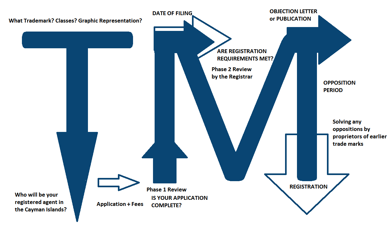About Loeb Smith
People
Sectors
Expertise
- Legal Service
- Banking and Finance
- Blockchain, Fintech and Cryptocurrency
- Capital Markets and Privatization
- Corporate
- Cybersecurity and Data Privacy
- Insolvency, Restructuring and Corporate Recovery
- Insurance and Reinsurance
- Intellectual Property
- Investment Funds
- Litigation and Dispute Resolution
- Mergers and Acquisitions
- Private Client and Family Office
- Private Equity and Venture Capital
- Governance, Regulatory and Compliance
- Entity Formation and Managed Services
- Consulting
- Legal Service
News and Announcements
Locations
Subscribe Newsletters
Contact
The New Cayman Islands Trademark Protection Rules
03 February 2017 . 8 min readIn the first two issues of our series of legal insights on owning intellectual property (IP) through a Cayman Islands structure, we discussed how the Cayman Islands aim to become an important offshore hub for the development and commercial exploitation of IP, some of the key benefits of being in the Special Economic Zone (SEZ) and certain advantages of incorporating an exempted company in the Cayman Islands (Incorporate Your Idea. How to Develop Your Intellectual Property in the Cayman Islands) and also how the Cayman Islands legal framework has been modernized to cover IP rights in the digital age and how trade secrets are protected in equity, with a special focus on FinTech companies (Financial Technology Intellectual Property (FinTech IP) Welcome in the Cayman Islands). In this third issue, we take a closer look at the “brand new” Cayman Islands Trade Marks Law, published on 19th December 2016 and which is expected to come into force early 2017, pursuant to which a stand-alone comprehensive trademark protection regime is created in the Cayman Islands (the “New Trade Marks Regime”) to replace the current system of extension of UK/EU IP rights.
Basic Concepts of the New Trade Marks Regime:
- A Classic Trade Mark Definition. The concept of “trademark” is defined, in line with the harmonized definition, which is currently applied throughout the European Union countries1, as any sign capable of being represented graphically which is capable of distinguishing goods or services of one undertaking from those of other undertakings. It may consist of words (including personal names) designs, numerals, letters or the shape of goods or their packaging2. However, upon a closer look, the Cayman Islands have not followed the most recent dematerialization trends in Europe, where, starting from September 2017, signs will be registered as trademarks if they are represented in any appropriate form (i.e., not only a graphic form) using generally available technology3.
- Cayman Register. A Register of Trade Marks will be maintained by a Registrar of Trade Marks (the “Registrar”) and will include details of applications for registration (including graphic representations of trade marks), filing dates and dates of priority, names of proprietors of registered trademarks, and any transactions or events affecting registered trademarks (such as an assignment, the grant of a licence, or the grant of any security interest, whether fixed or floating), which are filed with the Registrar in order to protect the rights in the registered trade mark against third parties4.
- Traditional Annual Registration Fees. One of the main features of the current system for trademark protection in the Cayman Islands, the annual registration fee, will remain in place under the New Trade Marks Regime. The proprietor of a registered trademark must, through its registered agent, pay a prescribed annual fee by January 1 of each year. If the annual fee remains unpaid at March 31, the rights shall be deemed to be in abeyance from April 1 until the annual fee and the prescribed penalty have been paid.
Transitioning to the New Trade Marks Regime and Practical Issues:-
While Regulations detailing the New Trade Marks Regime have not yet been published, the following questions and answers may give companies owning trademarks which are registered or which are planning to be registered shortly in the Cayman Islands, and their IP agents, some useful insight with respect to a few practical issues:
1. What information should be provided with an application for trademark registration and what will be the registration process under the New Trade Marks Regime?
An application to register a trademark in the Cayman Islands will include6, under the New Trade Marks Regime:
(a) a request for registration of a trademark;
(b) the name and address of the applicant;
(c) the name and address of the registered agent;
(d) a statement of the goods or services in relation to which it is sought to register the trademark;
(e) the classification of the goods or services; and
(f) a representation of the trademark.
After the application is complete, the Registrar will review the documentation provided, carry out a search of earlier trademarks in the Register of Trade Marks, and examine if requirements for registration are met7.
⇒ If requirements for registration are not met, the Registrar will inform and give the applicant an opportunity for representations or amendments.
⇒ If requirements for registration are met, applications will be published for opposition by third parties, with the opposition period being 60 (sixty) days following publication8.
The registration process is expected to last an average of three (3) months, and the registration of a trademark must be completed within six (6) months from the date of application, or the Registrar may treat the application as abandoned.

2. When is the trade mark protected?
Under the New Trade Marks Regime, the proprietor has exclusive rights in the registered trademark, preventing any use of the trademark in the Cayman Islands without the proprietor’s consent, starting with the date of filing of the application for registration10, which is the day on which the complete application is filed with the Registrar. (If the initial application is incomplete, the date of filing is the final day on which a relevant document was submitted11.)
Registration of a trademark will not be, however, enforceable against an unregistered earlier trademark which has been in constant use in the Cayman Islands12.
3. When will the registration of a trade mark be refused in the Cayman Islands?
As is customary for any trademark registration systems, the Registrar will refuse the registration of a trade mark13 which is devoid of any distinctive character, or which designates the kind, quality, quantity, purpose, value, geographical origin, time of production, or other characteristics of goods or services, or which is customary in the current language or the established practices of the trade. A trademark will also not be registered if it may deceive the public as to the nature, quality, geographical origin of the goods or services or any other characteristic of the goods or services.
Identical or similar trademarks will not be registered for similar goods or services because of the risk of confusion on the part of the public. Similar trademarks may be registered, however, subject to the consent of the proprietor of the earlier trade mark14 or upon the applicant showing honest concurrent use of the trademark for which registration is sought 15.
In addition to the grounds for refusal referred to above, the New Trade Marks Regime protects existing Cayman Islands’ businesses by restricting registration of trademarks which may take unfair advantage of, or be detrimental to, the distinctive character or the repute of an earlier similar trademark already registered or otherwise protected in the Cayman Islands and which has a reputation in the Cayman Islands16.
Also, the Registrar is prohibited by law17 from registering a trademark which consists exclusively of the word “Cayman”, “Cayman Islands”, “Grand Cayman”, “Cayman Brac”, “Brac” or “Little Cayman”. A trademark will also not be registered if it is contrary to public policy or to accepted principles of morality in the Cayman Islands. Furthermore, the Registrar may publish from time18 to time by notice in the Cayman Islands Gazette, a list of words, letters or devices which are restricted or prohibited to be used in connection with a trademark registration.
4. If the applicant receives a letter of objections, can a trade mark still be registered?
Depending on the objections of the Registrar, to avoid grounds for refusal or to resolve conflicts with existing trademarks, an applicant for registration of a trademark, or the proprietor of a registered trademark, may disclaim any right to the exclusive use of any specified element of the trademark or agree that the rights conferred by the registration shall be subject to a specified territorial or other limitation. This may also be required by the Registrar or the Cayman Court as a condition of the trademark being registered on the Register of Trade Marks19.
- Article 2 of the Directive 2008/95/EC of the European Parliament and of the Council
- Article 2(1) of the Trade Marks Law, 2016.
- The Amending Regulation (EU) No 2015/2424 removes the graphical representation requirement.
- Unless such transactions are registered in the Register of Trade Marks, assignees are not entitled to damages or an account of profits in respect of any infringement of the registered trade mark occurring after the date of the transaction. See Article 39 of the Trade Marks Law, 2016.
- Article 21 of the Trade Marks Law, 2016
- Article 13(2) of the Trade Marks Law, 2016
- Article 15 of the Trade Marks Law, 2016
- Article 16(2) of the Trade Marks Law, 2016
- Article 15(6) of the Trade Marks Law, 2016
- However, under Article 29(3) of the Trade Marks Law, 2016, no infringement proceedings may be begun before the date on which the trade mark is in fact registered.
- Article 14(2) of the Trade Marks Law, 2016
- Article 31(3) of the Trade Marks Law, 2016
- Article 23(1) of the Trade Marks Law, 2016
- Article 25(6) of the Trade Marks Law, 2016
- Article 26 of the Trade Marks Law, 2016; “honest concurrent use” means such use in the Islands by the applicant or use with the applicant’s consent, at the same time that use is made by the proprietor of the earlier trade mark.
- Article 25(3) of the Trade Marks Law, 2016
- Article 23(2) of the Trade Marks Law, 2016
- Article 23(5)(c) of the Trade Marks Law, 2016
- Article 33(4) of the Trade Marks Law, 2016
This is not intended to be a substitute for specific legal advice or a legal opinion.
Ramona Tudorancea
Corporate / M&A Specialist
Suite 329 | 10 Market Street | Camana Bay |
Grand Cayman KY1-9006 | Cayman Islands
E ramona.tudorancea@loebsmith.com
www.loebsmith.com
Latest Updates and Insights
INSIGHTS | 03 April 2025
First-step analysis: cryptoasset trading in Cayman Islands
Fiat currency transactions What rules and restrictions govern the exchange of fiat currency and cryptoassets? Assuming the subject cryptoassets fall within the definition of virtual assets under the Virtual Asset (Service Providers) Act (As Revised) (VASP Act), the exchange of fiat currency and cryptoassets will likely constitute a...
INSIGHTS | 18 March 2025
Key issues in series financing under BVI and Cayman Islands law
The British Virgin Islands and Cayman Islands companies remain key players in series financing transactions in Asia and beyond, offering a flexible, cost-competitive and well-tested means of deal structuring.
INSIGHTS | 12 March 2025
Key issues in series financing transactions from a BVI and a Cayman Islands law perspective
British Virgin Islands (“BVI”) and Cayman Islands companies have continued to play a significant role in series financing transactions in Asia and beyond as they offer a flexible, cost-competitive and well-tested means of deal structuring. The tax neutrality, the ability to close transactions electronically and the absence of...

INSIGHTS | 26 February 2025
Key Features of Cayman LLCs and the purposes for which they are used
Question: What are the key features of a Cayman LLC?

